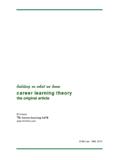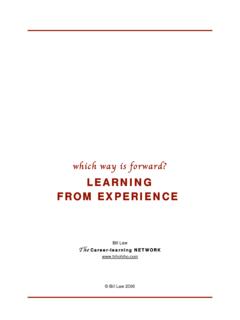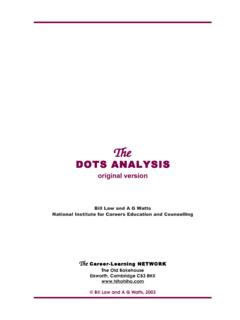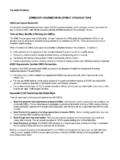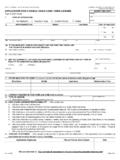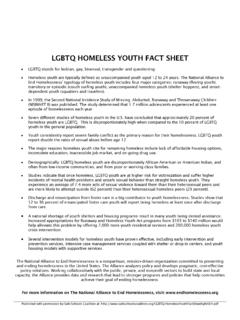Transcription of building on what we know - Career-learning Home Page
1 building on what we know community -interaction and its importance for contemporary careers-work Bill Law The Career-leaning NETWORK Bill Law - 1981, 1993, 2009 contents the story engaging a debate 1 what this is about 1 self versus opportunity 1 reshaping the issue 2 self-matching 2 community interacting 2 examining evidence 2 breaking new ground 2 following through 3 tracking take-up 3 performance for policy 3
2 DOTS and dissemination 4 more new thinking 4 developing practice 4 thinking conventionally 5 thinking again 5 thinking locally 6 narratives on the net 7 interrogating experience 8 contemporary importance of community interaction 8 references 9 the article community interaction a mid-range focus for theories of career development in young adults changing society - changing theory 11 scientific matching theories 11 humanistic theories 12 functionalist theories 13 evidence for community interaction in career development 14 studies in career development 14 studies in the sociology of education 15 studies in the sociology of the school 15 international comparisons 16
3 A mid-range focus 16 processes of community interaction 16 community as a transmitter of motivation 16 community as a modifier of social functioning 17 modes of community influence 17 theoretical formulation 17 parallel theories of guidance 20 pluralistic guidance in an unpredictable society 22 references in the original article 23 The 1993 republication commentary on community interaction 26 metatheory? 26 new theory 27 better than I knew? 28 references in the 1993 commentary 29 The Career-leaning NETWORK page 1 the story engaging a debate community interaction is the phrase used to refer to how people manage careers in a social context.
4 It was introduced into what was - and still is - an ongoing debate. In 1977 The British Journal of Guidance and Counselling (BJGC) gave space to two important but contrary voices. They were Peter Daws and Ken Roberts (both referenced on page 23). The debate was about whether career management was mainly about what people inwardly sought or what they were in a position to find. what this is about: It raises issues for the importance to career of inner life and other people. community -interaction thinking points to the ways that any sense of self is gathered from other people. In career that process needs managing in many different ways: we work with colleagues, we work for managers and customers, we work on behalf of family and in response to friends.
5 The details are in the article (page 11): it allows you confidently to say, to the most self-contained and inwardly-driven person you know , that her work is not just for her, it is for other people who count on her, and for anyone who will ever be dependent on her. Those other people have an interest in how career moves on - hers, yours and mine; and they may watch with interest how well career moves are worked through. Some of those people have a significant influence on how such things are resolved. And not all of those are career professionals. self versus opportunity: In the debate Ken Roberts argued that most people do not make career decisions in any recognisable sense, they take what s available.
6 He said that professional career-helpers should pay more attention to the socialising influence of upbringing, and also to the selective power of the opportunity structure. Both are other-people influences: the former causes your students and clients to want what the latter causes them to get. Ken was cautious about how much difference careers work could make to those dynamics. On the other hand, Peter Daws argued for the importance of ideas about the self, pointing to the fact that careers is not just a matter of identifying what employers want, but also about engaging what people seek. He looks to the importance of inner-life for how careers are managed.
7 And he holds that career professionals can help - particularly in careers education. Nobody argued that you could talk about opportunity without talking about self . So they both were set down, side-by-side, in what was to become an influential framework for our work. It was the DOTS analysis - also published in 1977. It spoke for the importance of learning concerning decision , opportunity , transition and self . Opportunity was always going to be part of such an analysis. Peter Daws thinking was there in decision and self . But the word transition is there because Ken Roberts insisted that not nearly enough can be explained in terms of decision.
8 Despite his doubts about the usefulness of our work, Ken may - through DOTS - have found more influence than he sought on its development. However, the DOTS analysis doesn t try to reconcile self to opportunity - it just lists features of each side-by-side, and leaves you to get on with it. The Career-leaning NETWORK page 2 reshaping the issue Opportunity-versus-self would have been a false dichotomy. People speak of both as one: I want to be an engine driver does so in a single breath. But it still leaves questions. One of them is among the most useful in careers work: what gave you the idea of doing that? . It probes how self and opportunity get it together.
9 Self matching: DOTS has some ready-made ideas for answering the what gave you the question. People are thought to move on in their career by matching the skills and interests of self to the availability and requirements of opportunity . The idea is embedded in the concept of employability: which is a readiness, by a free-and-responsible self, to move into a plainly-understood work opportunity. We therefore attach a lot of importance to reliably diagnosing skills-and-interests. And we take great care over assembling what we think of as impartial information. All is based on the idea that the one needs to be matched to the other.
10 It s pegs-and-holes thinking - widely embraced, and seeming to many to be perfectly obvious. community interacting: community -interaction thinking raises doubts what might seem obvious. The article (Law 1981) argues that what people know about opportunity, and the way they call on aspects of self, work in another way. what is obvious is that people learn about both from other people. But they learn in more than one setting, and that learning moves along a number of different paths. The way it all works out will, therefore, depend on what sort of attention a person gives to one person rather than another. Career management, then, becomes a matter, not so much of what you know concerning decisions and transitions, but of who you pay attention to among the people you know .

